Summary The veterinary activities went on successfully during the month of May, an adult male black rhino (Diceros bicornis) an endangered species in Kenya was treated twice in Lake Nakuru National park, it had sustained several injuries on the left hind leg, abdomen, eyes and perineum after it was fought by another dominant male
Summary
The veterinary activities went on successfully during the month of May, an adult male black rhino (Diceros bicornis) an endangered species in Kenya was treated twice in Lake Nakuru National park, it had sustained several injuries on the left hind leg, abdomen, eyes and perineum after it was fought by another dominant male. An investigation was carried out on an incidence of wildlife poisoning in Mara in which 34 vultures and one lion died, laboratory analysis of the samples is still on to identify the chemical used in poisoning. A female elephant with a two-month old calf was also treated of severe injuries on the abdomen, udder and shoulder of unknown cause; it has since recovered and takes good care of its young calf. Other cases of zebras and giraffes trapped with snares and with various injuries were handled successfully in Naivasha area. We are greatful for the support of the David Sheldrick Wildlife Trust (DSWT) towards provision of veterinary services to wildlife in Mara and other parts of Central Rift, through this support; the veterinary unit in Mara has been able to respond to all reported cases that require veterinary attention in Mara and Central Rift region.
TREATMENT OF AN INJURED BLACK RHINO (Diceros bicornis) IN LAKE NAKURU NATIONAL PARK:
Lake Nakuru National park is one of the Kenya's most important rhino breeding sanctuaries; it has both black and white rhinos free ranging in the park. The KWS veterinary department has always been contacted whenever there is a case that requires veterinary attention within the park. Rhinos in the park have been treated for injuries sustained from territorial fights or injuries inflicted by foreign materials such as sharp objects that threaten the survival of these endangered species.
Recently the park management and rhino surveillance team reported to the veterinary department that one of the male black rhinos called 'Kagiri' was seen limping and was visibly in deep pain, it had lost much of its body condition and became very docile possibly due to pain and fear of being attacked by other dominant males in the park, it therefore required an urgent veterinary attention. One of its horns had been broken earlier when it was engaged in a terrible fight with another dominant male which was not identified. The Central Rift veterinary unit from Masai Mara received the report and managed to attend to the rhino at the right time.
The rhino was treated of extensive severe injuries on the abdomen, hind legs, on the perineum and on the inguinal region and one of the eyes had extensive lesions on the peri-orbital fossa and had developed some form of keratoconjuctivitis causing partial blindness. The wounds were already infected and a lot of pus exudation could be seen from a distant. The animal had developed some weakness and was quite reluctant to move most of the times.
RHINO IDENTIFICATION:
Name -Kagiri
Sex -Male
Age -3 years
Identification No. 0521
Weight -Approx 800kgs
Date of treatment: 29/04/2009
Time: 1730 hours
Location: Naishi GPS 0176045 – Eastings, 9948896 – Northings.
IMMOBILIZATION AND CAPTURE:
After making extensive foot patrol in the park searching for the injured, it was located from a densely vegetated area near Naishi rhino camp. The animal was then captured by darting from a vehicle using a Dan-inject dart gun, the drugs used were 4.5mgs of etorphine hydrochloride combined with 80mgs of xylazine hydrochloride. It took about 5 minutes for the drug to take effect and the animal went down on lateral recumbency, then 10mgs of Narlophine hydrochloride was administered through the ear vein to help improve the respiratory rate which was recorded at 36 cycles per minute while the body temperature was 39.0 oC. While it was being treated, the animal was continuously dowsed with a lot of water to help control its body temperature.
EXAMINATION AND TREATMENT:
The animal had deep penetrating wounds on the ventral side of the abdomen, the right hind leg had a very deep infected wound on the tarsal joint that extended into the joint cavity causing partial dislocation of the joint, this was the main injury causing lameness to the rhino. Other injuries on the left eye, perineum and on the prepuce were already infected and exudating much pus.
The wounds were flushed with hydrogen peroxide 10% and then treated using a tincture of iodine then sprayed with oxytetracycline spray. The rhino was also treated with long acting Betamox (antibiotic) injection, multivitamins and dexamethasone. Blood samples were collected for further laboratory analysis.
ANAESTHETIC REVIVAL:
After treatment, the animal was revived from anaesthesia using 24mgs of Diprenorphine hydrochloride combined with 5mgs of Aipamezole hydrochloride administered through the ear vein. It rose up after about 4 minutes and took off to the nearby shrubs.
PROGNOSIS:
It had a good prognosis because it was reported and treated in good time, septiceamia had not set in, and the wounds also showed good signs of healing. Even though it had lost much of its body condition due to pain and stress, the rhino was still very strong with good appetite and can easily recover from the injuries. It is being monitored daily and the treatment might be repeated if need be.
REPEAT TREATMENT OF THE RHINO IN NAKURU
A repeat treatment was done after two weeks to ensure an enhanced recovery, this time the animal had lost much of its body condition but still had better chances of recovery. Same treatment was done as before including sufficient dosages of long-acting antibiotics and antinflammatory drugs. After treatment, it was released back to the wild, but was to be monitored closely for progress.
Treatment of an injured Maasai Giraffe in Sanctuary farm Naivasha
This was an adult male giraffe that had been sighted while limping with a severe injury on the interdigital space of the left front leg. The limb was greatly swollen on the distal part of the carpal joint. It was so painful that the giraffe had difficulties in movement and could be seen limping with a lot of pain. The case was reported to the vet by one of the residents who felt concerned about the pain and suffering of the giraffe and wanted to save its life.
Chemical restrain and treatment
The giraffe was found alone in an open area far from the rest of the herd, it was then captured by chemical immobilization through darting using 13mgs of etorphine hydrochloride combined with 30mgs of Xylazine hydrochloride. It took about 5 minutes to become recumbent.
The wound was examined and found to have been caused by a very sharp object penetrating between the two digits of the front leg, there was no foreign body in it. It was then cleaned and debrided using 10% hydrogen peroxide and a tincture of iodine applied topically then sprayed with oxytetracycline spray Other treatments using long-acting antibiotics multivitamins administered intramuscularly to help treat systemic infection.
Revival of anaesthesia
After treatment the giraffe was revived from anaesthesia using 5mgs of Atipamezole hydrochloride combined with 36mgs of Diprenorphine hydrochloride administered through the jugular vein. It woke up after about 2 minutes and was assisted by ropes to rise up. It had good chances of recovery after treatment.
Treatment of an elephant Koiyaki-Lemek conservancy in Masai Mara.
This was a case of an adult female elephant with its two calves; both the calves were males, one aged about 3 years while the youngest one aged about 2 months. It had extensive injuries on the entire ventral side of the abdomen with accumulative pus; one of the udders was completely necrotized and was no longer functional. The elephant was in a great pain and could not keep pace with the rest of the herd opting to remain behind with its two young ones.
The younger calf was still too young and was wholly dependent on suckling the mother therefore injuries to the udder would lead to agalactae (complete loss of milk from the mammary glands) and starvation to the calf. Fortunately, one of the udders was not affected and remained functional to feed the calf. The elephant had been in a great pain for sometime and was beginning to loose its body condition when it was reported to the veterinarian by the management of Duma camp in Koiyaki- Lemek conservancy.
The conservancy rangers and other staff from Ol-Choro-Oiroua Conservancy assisted in searching for the elephant, a fixed wing aircraft from Mara Conservancy (Mara Triangle) also assisted in spotting the elephant from above. After several hours of search, it was sighted at the edge of a small stream while grazing with its two young ones.
Chemical immobilization and treatment
We managed to capture the elephant by darting from a vehicle using 15mgs of etorphine Hcl and 1500 i.u of hyaluronidase; it went recumbent after about 5 minutes. All the wounds were well cleaned using a lot of water draining all the cumulated pus from the lower abdomen and then debrided using 10% hydrogen peroxide and topical application of tincture of iodine. Oxytetracycline antibiotic spray was then applied, and a further intramuscular administration of long-acting antibiotics and dexamethasone provided. The intact udder was tested by milking and confirmed to be normal and could help sustain the calf until the mother recovered.
Revival of anaesthesia and prognosis
After treatment, the elephant was revived from anaesthesia using 48mgs of diprenorphine hydrochloride administered through the ear-vein; it rose up after 2 minutes and managed to join its two young ones.
The elephant had better chances of healing because the wounds were open and mainly on the subcutaneous tissues, septiceamia had not set in by the time of treatment, it was still strong with good appetite and could easily regain its lost body condition. Meanwhile the conservancy managers and rangers were instructed to keep monitoring the elephant and report its progress daily to the vet so that the calf could be rescued should the mother die, so far they reported good recovery.
Rescue of snared zebra in Iroko farm in Naivasha
This was a case of an adult female zebra which had a loose wire snare round the neck. It was immobilized by darting using 5mgs of etorphine hydrochloride combined with 80mgs of Xylazine hydrochloride and it took about 4 minutes to become recumbent. After it was fully anaesthetized and went recumbent, the loose wire was then cut off using a wire cutter. The wire had inflicted a mild injury on the ventral side of the neck; this was treated by topical application of tincture of iodine and oxytetracycline spray. 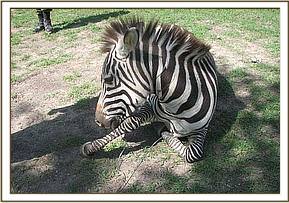
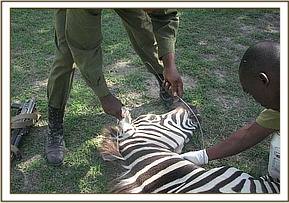

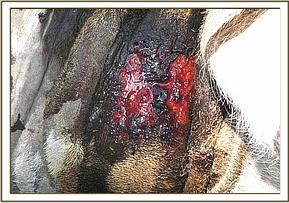

The zebra was then revived from anaesthesia using 12mgs of Diprenorphine hydrochloride combined with 5mgs of Atipamezole hydrochloride; it took about 2 minutes to rise up and joined others.
Conclusion
Cases of wildlife injuries due to human-wildlife conflicts are still on the rise in Mara, Naivasha and Ruma National park. Snaring and injuries of giraffes and common zebras in Naivasha are still a great threat to wildlife conservation in the area. The Central Rift veterinary unit through the support of Kenya Wildlife Service and the David Sheldrick Wildlife Trust (DSWT) continue to rescue as many animals as possible both in the Mara ecosystem and other parts of Central Rift. The unit still requires a laboratory technologist, solar panel and a refrigerator for storing biological samples from the field before being submitted to lab.
INCIDENCES OF POISONING OF VULTURES AND LIONS IN MASAI MARA NATIONAL RESERVE
BACKGROUND INFORMATION:
An incident of wildlife poisoning occurred in Mara on the evening of Saturday 23rd May, 2009 at Oloolaimutiak area barely 2 Kms away from Oloolaimutiak gate but within the reserve, GPS location 36M 0762759, UTM 9819530. However, it was until the following day, Sunday 24th when a group of tourists at the back of a tour van saw several vultures dead while a few others were still staggering and walking in uncoordinated manner, the tourists became suspicious with the incident and reported to the County Council rangers and management of Mara who in turn informed KWS veterinarian and other officers from Narok station. It was immediately suspected that the vultures had died of poisoning which required an urgent investigation to find out the source.
A thorough investigation was conducted by the KWS veterinarian and assistant research scientist from Mara to find out the cause of death. Meanwhile a team of KWS rangers and investigation officers from Narok also joined and did a thorough search of the area trying to get the persons who were involved in poisoning the animals. It was later revealed that a total of thirty four (34) vultures of different sub-species and a pride of five (5) lions fed on a poisoned bovine carcass and suffered an acute toxicity leading to death. Two more vultures were found dead the following day making it a total of thirty six (36) vultures dead. Since then no further mortalities have been reported from the incident.
All the thirty six (36) vultures were confirmed dead and one (1) male lion aged about 8 months was found dead just a few meters away from the poisoned bovine carcass. The bovine carcass was completely consumed by the vultures and lions, only a few bones of the ribs attached to the vertebral column, skeletal appendages, and bones of the head could be found. Most of these bones were closely examined and found to be stained with a characteristic pink chemical solution, the toxic agent that was deliberately applied onto the carcass to kill lions. 

Further inquiry from the County council rangers revealed that prior to poisoning; lions had attacked and killed four (4) cattle from larger herd of cattle that were grazing in the reserve at night. The owners of the cattle were seen slaughtering and transporting the meat of the killed cattle on a bicycle. It was therefore suspected that they carried all the meat and finally poisoned one of the bovine carcasses intentionally to kill lions and other wildlife which had attacked their herd. It was their way of retaliating for the loss of their cattle.
CLINICAL SIGNS OF POISONED VULTURES
Just before death, most vultures were seen staggering, uncoordinated movement, limb and neck paralysis, some were vomiting, general weakness, dyspnea (difficulty in breathing), collapse and death. The other four lions which also fed on the poisoned carcass could not be sighted anywhere within the proximity of the area and it is assumed that they survived from the effect of the poison or they all died in inaccessible areas. Therefore no clinical signs in lions were recorded before death.
POSTMORTEM EXAMINATION RESULTS
Lion (8 month old male).
The lion carcass was only one day old when postmortem examination was done, there was a little putrefaction and decomposition had started. Most significant lesions included pulmonary oedema, congestion and ecchymotic haemorrhage of the lungs, the liver was completely decomposed and only remained as dark fluidy substance in the abdominal cavity, spleen had also decomposed completely. The stomach was full of food which could be identified in-situ as bovine meat (see the piece of bovine ear on the picture below). The lion had fed on skeletal muscles, visceral and intestinal organs of the bovine. It died immediately after feeding and very little digestion had occurred by the time of death. The pieces of meat in the stomach also had a characteristic pink colour of the chemical observed on the bovine carcass, an evidence that the lion fed on the chemical. The lion was in a very good body condition and must have died of an acute toxicity. 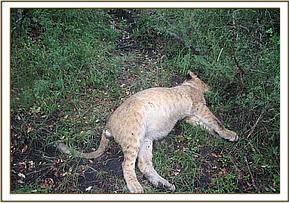

Vultures (34 individuals)
Fifteen vultures had vomited and had scant or no food contents in the stomach or crop (loop), 19 of the vultures had full contents in the crop (loop) or in the stomach. All the vultures with full contents had the characteristic pink colour of the chemical on the food contents of the crop and stomach. One vulture was seen with blood vomitus in the oral cavity. All the birds were in good body condition and were found dead barely 50 meters away from the bovine carcass, little or no digestion had taken place by the time of death which is a clear sign of an acute toxicity. Three different species of vultures were affected, that is 32 African white backed vultures, 1 lappet-faced vulture and 1 hooded vulture. 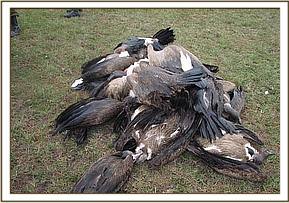
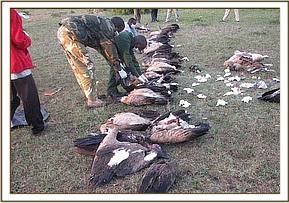

SAMPLES COLLECTION AND ANALYSIS
All the relevant samples including crop (loop) contents and liver from vultures, stomach contents, liver, heart and kidneys from the lion and poisoned bone tissues from bovine carcass, were collected by KWS Veterinarian and immediately submitted to the University of Nairobi department of Public Health Pharmacology and Toxicology, Kabete and the Government Chemist laboratories. Toxicological analysis is on-going and results still awaited.
TESTS REQUESTED FOR
All the laboratories have been requested to perform spot-on qualitative test for carbamates including carbofuran (Furadan), organophosphates including amitraz, chlorphenviphos (steladone) and Diazinone, organo-chlorines. An advanced test HPLC will also be done to confirm the results of the spot-on test. Quantitative tests will also be done on liver and stomach contents to verify the concentration and amounts of the chemical used in poisoning. Other poisonous substances like strychnine and cyanide may also be tested for.
RESULTS
Analysis is going on in the University of Nairobi (UoN) laboratory and Government chemist. Already UoN have hinted negative results for organophosphates and organo-chlorines and they are yet to analyse for carbamates (carbofuran) pesticide the main suspect poison in this case. Any conclusive remarks on the type of chemical used can only be made after laboratory test results are out.
DISPOSAL OF CARCASSES
All the vulture, lion and bovine carcasses were disposed of by burning using petrol fuel, this was done properly to avoid further environmental contamination and exposure of the poisonous chemical to other animals particularly hyenas which would have consumed vulture and lion carcasses. By destroying these carcasses, no further wildlife mortalities was experienced and no more mortalities are expected from this incident. 
DISCUSSIONS
This is the second time when the lions have suffered from poisoning in Mara, in April, 2008, a pride of 6 male lion got poisoned from yet unidentified source near Mara Serena lodge along Mara river, two of the lions died at the scene while the rest disappeared with clinical signs of paralysis and incoordination gait and were presumed dead. This was likely to be an incidental poisoning after the lions fed on a hippo carcass that apparently died after grazing on a vegetable farm sprayed with a pesticide, due to indirect exposure and less concentration of the chemical on the hippo carcass, the severity of the symptoms in lions was mild and death only occurred after 2 – 3 days.
The poisoning this month was acute and very severe, presented with an instant death soon after feeding on the carcass. This was an intentional poisoning as opposed to the previous one, and involved deaths of several vultures already confirmed and examined. Previous poisoning was confirmed at the Government chemist as carbamates (Carbofuran) which is sold in Kenya as Furadan. It is very likely that the same Carbofuran (Furadan) chemical has been used to poison animals again this time. The laboratory results will confirm this.
Furadan is a trade name for Carbofuran which is a pesticide classified as an insecticide and nematocide. It belongs to the chemical family of carbofuran, the generic name being 2,3-dihydro-2,2dimethyl-7-benzofuranyl methylcarbamate. It was first registered for use as a pesticide in 1969 and is currently produced by FMC Corporation of U.S. Other trade names of this pesticide available in the market are Curaterr and Yaltox. It is used to control pests in fruits, field crops, vegetables, flower farms and forests. Methods of application are through aerial and ground application as a granular or spray form.
It acts by inhibiting the effects of Acetyl-cholinesterase enzyme that is involved in coordination of nerve functions, and with that it causes muscle paralysis and death of pests or any other animal in contact with it. Carbofuran (Furadan) is highly toxic to fish, birds and other wildlife species, it is known to leach through soil and has been found in groundwater as a result of agricultural use.
Toxicological Effects of carbofuran
Acute toxicity: Carbofuran is highly toxic by inhalation and ingestion and moderately toxic by dermal absorption. As with other carbamate compounds, carbofuran's cholinesterase-inhibiting effect is short-term and reversible. Symptoms of carbofuran poisoning include: nausea, vomiting, abdominal cramps, sweating, diarrhea, excessive salivation, weakness, imbalance, blurring of vision, breathing difficulty, increased blood pressure, and incontinence. Depending on the concentration and the amount of chemical consumed by an animal, only a few of these symptoms can be noticed before death.
Death may result at high doses from respiratory system failure associated with carbofuran exposure. Complete recovery from an acute poisoning by carbofuran, with no long-term health effects, is possible if exposure ceases and the victim has time to regain their normal level of cholinesterase and to recover from symptoms, (Baron, R. L; 1991).
Ecological Effects:
Carbofuran is highly toxic to humans, wildlife, birds, many fish and bees. One granule is sufficient to kill a small bird. Bird kills have occurred when birds ingested carbofuran granules, which resemble grain seeds in size and shape, or when predatory or scavenging birds have ingested small birds or mammals that have eaten carbofuran pellets.
Environmental Fate:
Carbofuran is soluble in water and is moderately persistent in soil. Its half-life is 30 to 120 days this is a very long time and can lead to much exposure to wildlife. In soil, carbofuran is degraded by chemical hydrolysis and microbial processes. Hydrolysis occurs more rapidly in alkaline soils. Carbofuran breaks down in sunlight. Carbofuran has a high potential for groundwater contamination (Howard, P. H, 1991).
In water, carbofuran is subject to degradation by chemical hydrolysis under alkaline conditions. Photodegradation and aquatic microbes may also contribute to degradation. The hydrolysis half-lives of carbofuran in water at 25 C are 690, 8.2, and 1.0 weeks at pH values of 6.0, 7.0, and 8.0, respectively. Carbofuran does not volatilize from water, nor does it adsorb to sediment or suspended particles (Howard, P. H, 1991).
The half-life of carbofuran on crops is about 4 days when applied to roots, and longer than 4 days if applied to the leaves (Bethesda M. D, 1995).
RECOMMENDATIONS
Due to rapid increase in human population and settlements, there is much habitat loss for both wildlife and livestock particularly in the Mara ecosystem, this has resulted to immense livestock incursion into the Masai Mara game reserve and increased human-wildlife conflict resulting in increased incidences of wildlife poisoning. The following recommendations are necessary to control further incidences of wildlife losses due to poisoning, snaring and other forms of injuries.
- In order to save the lives of many Kenyan wildlife which are threatened by the effects of Carbofuran use, the manufacturers of Furadan have decided to withdraw the chemical from Kenyan market and buy off all the existing stock in local shops.
- The management of Masai Mara should completely deter livestock from grazing into the reserve; this will reduce incidences of wild carnivores preying on livestock and reduce incidences of farmers poisoning animals to retaliate when their livestock is killed.
- Community education and awareness on benefits of wildlife conservation and effects of these poisonous chemicals in the environment.
- Continuous and systematic investigation on the types of chemicals used in wildlife poisoning in Mara and their effects on various wildlife species survival. This will help to enforce strict regulation on sale and use of these chemicals in Kenyan market to reduce incidences of wildlife poisoning.
- Change in land-use policy from crop and livestock farming to wildlife conservation in Mara ecosystem.
- Acquire more space for wildlife conservation in Mara through setting up of community sanctuaries and conservancies around the reserve in order to protect wildlife dispersal areas for wildlife.
Report by: Dr. Domnic Mijele